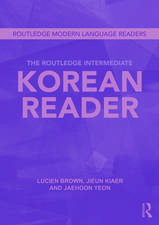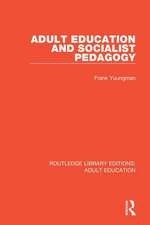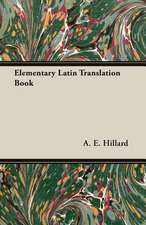Korean: A Comprehensive Grammar: Routledge Comprehensive Grammars
Autor Jaehoon Yeon, Lucien Brownen Limba Engleză Paperback – 8 iul 2019
The book moves from the alphabet and pronunciation through morphology and word classes to a detailed analysis of sentence structures and semantic features such as aspect, tense, speech styles and negation.
Updated and revised, this new edition includes lively descriptions of Korean grammar, taking into account the latest research in Korean linguistics. More lower-frequency grammar patterns have been added, and extra examples have been included throughout the text.
The unrivalled depth and range of this updated edition of Korean: A Comprehensive Grammar makes it an essential reference source on the Korean language.
| Toate formatele și edițiile | Preț | Express |
|---|---|---|
| Paperback (1) | 418.48 lei 3-5 săpt. | +40.13 lei 7-13 zile |
| Taylor & Francis – 8 iul 2019 | 418.48 lei 3-5 săpt. | +40.13 lei 7-13 zile |
| Hardback (1) | 891.36 lei 6-8 săpt. | |
| Taylor & Francis – 9 iul 2019 | 891.36 lei 6-8 săpt. |
Din seria Routledge Comprehensive Grammars
- 19%
 Preț: 524.21 lei
Preț: 524.21 lei - 19%
 Preț: 512.23 lei
Preț: 512.23 lei - 19%
 Preț: 401.06 lei
Preț: 401.06 lei - 19%
 Preț: 406.43 lei
Preț: 406.43 lei - 23%
 Preț: 551.43 lei
Preț: 551.43 lei - 19%
 Preț: 486.16 lei
Preț: 486.16 lei - 19%
 Preț: 442.91 lei
Preț: 442.91 lei - 19%
 Preț: 463.46 lei
Preț: 463.46 lei -
 Preț: 399.51 lei
Preț: 399.51 lei - 23%
 Preț: 701.68 lei
Preț: 701.68 lei - 19%
 Preț: 468.63 lei
Preț: 468.63 lei - 19%
 Preț: 445.73 lei
Preț: 445.73 lei - 23%
 Preț: 621.50 lei
Preț: 621.50 lei - 19%
 Preț: 403.69 lei
Preț: 403.69 lei - 19%
 Preț: 427.51 lei
Preț: 427.51 lei - 19%
 Preț: 521.87 lei
Preț: 521.87 lei -
 Preț: 402.12 lei
Preț: 402.12 lei - 19%
 Preț: 448.27 lei
Preț: 448.27 lei - 23%
 Preț: 539.14 lei
Preț: 539.14 lei - 14%
 Preț: 594.14 lei
Preț: 594.14 lei - 19%
 Preț: 482.40 lei
Preț: 482.40 lei - 19%
 Preț: 480.69 lei
Preț: 480.69 lei -
 Preț: 305.55 lei
Preț: 305.55 lei - 23%
 Preț: 561.23 lei
Preț: 561.23 lei - 15%
 Preț: 589.43 lei
Preț: 589.43 lei - 19%
 Preț: 416.72 lei
Preț: 416.72 lei - 19%
 Preț: 484.67 lei
Preț: 484.67 lei - 15%
 Preț: 619.52 lei
Preț: 619.52 lei - 25%
 Preț: 1020.84 lei
Preț: 1020.84 lei
Preț: 418.48 lei
Nou
Puncte Express: 628
Preț estimativ în valută:
80.07€ • 83.60$ • 66.27£
80.07€ • 83.60$ • 66.27£
Carte disponibilă
Livrare economică 14-28 martie
Livrare express 28 februarie-06 martie pentru 50.12 lei
Preluare comenzi: 021 569.72.76
Specificații
ISBN-13: 9781138064492
ISBN-10: 1138064491
Pagini: 570
Ilustrații: 20 Tables, black and white
Dimensiuni: 156 x 234 x 38 mm
Greutate: 0.79 kg
Ediția:2 ed
Editura: Taylor & Francis
Colecția Routledge
Seria Routledge Comprehensive Grammars
Locul publicării:Oxford, United Kingdom
ISBN-10: 1138064491
Pagini: 570
Ilustrații: 20 Tables, black and white
Dimensiuni: 156 x 234 x 38 mm
Greutate: 0.79 kg
Ediția:2 ed
Editura: Taylor & Francis
Colecția Routledge
Seria Routledge Comprehensive Grammars
Locul publicării:Oxford, United Kingdom
Cuprins
- Introduction to the Korean Language1.1 Characteristic Features of Korean
1.1.1 Word Classes
1.1.2 Word Order: Korean is an SOV language
1.1.2.1 Flexible Word Order
1.1.2.2 The Postpositional Characteristic of Korean
1.1.2.3 The Position of Complements
1.1.2.4 Interrogative Word Order
1.1.3 An Intricate System of Honorific Categories
1.1.4 Korean as an Elliptical Language
1.2 Korean Script and Pronunciation
1.2.1 Basic Principles of Hangul Writing
1.2.1.1 Letter Names and Dictionary Order
1.2.1.2 Writing Syllabically
1.2.2 Hangul Pronunciation Guide
1.2.2.1 Simple Vowels
1.2.2.2 Y-Vowels
1.2.2.3 W-Vowels
1.2.2.4 The Compound Vowel 의
1.2.2.5 Basic Consonants
1.2.2.6 Aspirated Consonants
1.2.2.7 Tensed or ‘Double’ Consonants
1.2.3 Pronunciation Changes
1.2.3.1 Pronunciation of Syllable-final Consonants
1.2.3.2 Simplification of Consonant Clusters
1.2.3.3 Re-syllabification
1.2.3.4 Nasal Assimilation
1.2.3.5 ㄹ r/l pronounced as ㄴ n
1.2.3.6 ㄴ n pronounced as ㄹ l
1.2.3.7 Palatalisation of ㄷ t and ㅌ t’
1.2.3.8 ㄴ n Addition
1.2.3.9 ㅎ h Reduction
1.2.3.10 Aspiration
1.2.3.11 Reinforcement - Nouns, Nominal Forms, Pronouns and Numbers
- Nouns
2.1.1 Lack of Articles, Number and Gender
2.1.1.1 Lack of Articles
2.1.1.2 Lack of Number
2.1.1.3 Lack of Gender
2.1.2 Bound/Dependent Nouns
2.1.2.1 것 ‘thing, ‘object’ or ‘affair’
2.1.2.2 겸 ‘-cum-‘
2.1.2.3 곳 ‘place’
2.1.2.4 김 ‘occasion, chance’
2.1.2.5 대로 ‘in accordance with’
2.1.2.6 덕분 ‘thanks to’
2.1.2.7 데 ‘place’
2.1.2.8 동안 ‘during’
2.1.2.9 둥 ‘may or may not’
2.1.2.10 듯 ‘as if’
2.1.2.11 따름 ‘only, alone’
2.1.2.12 때 ‘when’
2.1.2.13 때문 ‘reason’
2.1.2.14 리 ‘reasons’
2.1.2.15 무렵 ‘around the time’
2.1.2.16 바 ‘thing’
2.1.2.17 뿐 ‘only’, ‘just’, ‘nothing but’
2.1.2.18 수 ‘case’, ‘circumstance’
2.1.2.19 적 ‘event’
2.1.2.20 줄 ‘the way’, ‘the fact’
2.1.2.21 중/도중 ‘middle’
2.1.2.22 지 ‘since’
2.1.2.23 쪽 ‘side’
2.1.2.24 채 ‘just as it is’ - Nominal Forms
2.2.1 Nominal Form -이
2.2.2 Nominal Form -개/-게
2.2.3 Nominal Form -기
2.2.4 Sentence Patterns with –기
2.2.4.1 –기 나름이 ‘depending …’)
2.2.4.2 –기 때문에 ‘because …’)
2.2.4.3 –기/게 마련이– ‘be bound to …’)
2.2.4.4 –기(에) 망정이– ‘fortunately … otherwise’
2.2.4.5 –기 시작하- ‘start …’
2.2.4.6 –기 십상이– ‘it is easy to …’
2.2.4.7 –기 위하– ‘in order to’
2.2.4.8. –기 이를 데 없–/그지 없– ‘boundless, endless’
2.2.4.9 –기 일쑤이– ‘be apt to …’
2.2.4.10 –기 전 ‘before …’
2.2.4.11 –기 짝이 없- ‘very …’
2.2.4.12 –기나 하- ‘just …’
2.2.4.13 –기는 ‘no way’
2.2.4.14 –기는 하– ‘indeed’
2.2.4.15 –기(는)커녕 ‘far from …’
2.2.4.16 –기도 하– ‘also …’
2.2.4.17 –기만 하- ‘only …’
2.2.4.18 –기로 하– ‘decide to …’
2.2.4.19 –기로 되– ‘be supposed to …’
2.2.4.20 –기를/길 바라– ‘hope …’
2.2.4.21 –기에 ‘upon, because …’
2.2.4.22 –기에 따라- ‘depending on …’
2.2.5 Nominal Form –음
2.2.6 Using –(으)ㄴ/는 것 to Create Nominal Forms - Pronouns
2.3.1 Personal Pronouns
2.3.1.1 First Person Pronouns
2.3.1.2 Second Person Pronouns
2.3.1.3 Third Person Pronouns
2.3.2 Demonstrative Pronouns
2.3.3 Reflexives and Reciprocals
2.3.4 Interrogative Pronouns (Wh-words) - Numbers and Counting
2.4.2 Which System to Use
2.4.3 Sentence Patterns with Numbers
2.4.4 Counting and Naming Periods of Time
2.4.4.1 Years
2.4.4.2 Months
2.4.4.3 Weeks
2.4.4.4 Days
2.4.4.5 Telling the Time
2.4.4.6 Telling the Date
- Particles
3.2 Case Particles
3.2.1 The Subject Particle 이/가
3.2.2 The Object Particle 을/를
3.2.3 The Possessive Particle 의
3.2.4 Particles of Movement and Location
3.2.4.1 에 ‘to/in/at’
3.2.4.2 에다(가) ‘in/to’
3.2.4.3 에서 ‘from/in/at’
3.2.4.4 에게/한테 ‘to’
3.2.4.5 더러 ‘to’
3.2.4.6 보고 ‘to’
3.2.4.7 에게서/한테서 ‘from’
3.2.4.8 (으)로부터 ‘from’
3.2.4.9 Particle phrase (으)로 하여금 ‘letting/making (someone do something)’
3.2.5 Instrumental Particles
3.2.5.1 (으)로 ‘by/with/as’
3.2.5.2 (으)로서 ‘as’
3.2.5.3 (으)로써 ‘by means of’
3.2.5.4 Particle phrase (으)로 인해(서) ‘due to’
3.2.6 Comitative Particles
3.2.6.1 과/와 ‘and/with’
3.2.6.2 하고 ‘and/with’
3.2.6.3 (이)랑 ‘and/with’
3.2.7 Vocative Particle 아/야
3.3 Special Particles
3.3.1 The Plural Particle 들
3.3.2 Particles of Topic and Focus
3.3.2.1 The topic particle은/는
3.3.2.2 (이)야 ‘if it’s …’
3.3.2.3 (이)야말로 ‘indeed’
3.3.3 Particles of Extent
3.3.3.1 만 ‘only’
3.3.3.2 뿐 ‘only’
3.3.3.3 밖에 ‘except for’
3.3.3.4 부터 ‘from’
3.3.3.5 까지 ‘up until’
3.3.3.6 도 ‘also’, ‘even’
3.3.3.7 조차 ‘even’
3.3.3.8 마저 ‘even’
3.3.3.9 치고/치고는 ‘with exception’, ‘pretty … for a …’
3.3.3.10 커녕 ‘far from’
3.3.4 Particles of Frequency
3.3.4.1 마다 ‘every’
3.3.4.2 씩 ‘apiece’
3.3.5 Particles of Approximation and Optionality
3.3.5.1 쯤 ‘about’
3.3.5.2 (이)나 ‘about’, ‘or’, ‘just’
3.3.6 Particles of Comparison and Contrast
3.3.6.1 처럼 ‘like’
3.3.6.2 같이 ‘like’
3.3.6.3 만큼 ‘as … as’
3.3.6.4 보다 ‘more than’
3.3.6.5 따라 ‘unusually’
3.3.6.6 대로 ‘in accordance with’
4. Verbs
4.1 Characteristics of Korean Verbs
4.1.1 Types of Verbs: Processive and Descriptive
4.1.2 Types of Verbs: 하– Verbs
4.1.3 Types of Verbs: Negative Verbs
4.1.4 Types of Verbs: The Copula (Equational Verb)
4.1.5 Verb Bases
4.1.6 The Infinitive Form
4.1.7 The Dictionary Form
4.1.8 Attaching Verb Endings
4.2 Negatives
4.2.1 Short Negatives with 안 and 못
4.2.2 Long Negatives with –지 않– and –지 못하–
4.2.3 Negative Commands and Proposals with –지 말–
4.2.4 Expressions that Require Negative Verbs
4.3 Tense and Aspect
4.3.1 Past Tenses
4.3.1.1 Simple Past –았/었–
4.3.1.2 Past-Past or Discontinuous Past –았/었었–
4.3.1.3 Observed or Perceived Past Tense –더–
4.3.2 Future Tenses
4.3.2.1 –겠–
4.3.2.2 –(으)ㄹ 거–
4.3.2.3 Other Forms with Future-related Meanings
4.3.2.4 Summary of Korean Futures
4.3.3 Continuous Tense
4.3.3.1 Continuous States with –아/어 있–
4.3.3.2 Continuous Actions with –고 있–
4.4 Derived Verbs: Passives, Causatives and Others
4.4.1 Passives
4.4.1.1 Derived Passive Verbs
4.4.1.2 Passives with 되–
4.4.1.3 Passives with Other Support Verbs
4.4.1.4 Passives with –아/어 지–
4.4.2 Causatives
4.4.2.1 Derived Causative Verbs
4.4.2.2 Causatives with –게 하–
4.4.2.3 Causatives with –도록 하–
4.4.2.4 Causatives with 시키–
4.4.3 Transforming Descriptive Verbs into Processive Verbs
4.4.3.1 Forming Processive Verbs with –지–
4.4.3.2 Forming Processive Verbs with –하–
5. Auxiliary (Support) Verbs
5.1 Auxiliary Verbs with –(아/어)
5.1.1 –(아/어) 가– (ongoing activity "away")
5.1.2 –(아/어) 오– (ongoing activity "towards")
5.1.3 –(아/어) 내– (finish, achieve)
5.1.4 –(아/어) 놓– (do all the way)
5.1.5 –(아/어) 두–(do for future reference)
5.1.6 –(아/어) 대– (do repeatedly)
5.1.7 –(아/어) 버리– (do completely for regret or relief)
5.1.8 –(아/어) 보– (try doing)
5.1.9 –(아/어) 보이– (seem)
5.1.10 –(아/어) 빠지– (lapse into a negative state)
5.1.11 –(아/어) 쌓– (do repeatedly)
5.1.12 –(아/어) 주– (perform a favour)
5.1.13 –(아/어) 치우– (do rashly)
5.2 Auxiliary Verbs with –(아/어)다
5.2.1 –다 말– (stop after)
5.2.2 –다 보– (after trying doing)
5.2.3 –다 주– (run an errand)
5.3 Auxiliary Verbs with –고
5.3.1 –고 나– (after finishing)
5.3.2 –고 말– (end up)
5.3.3 –고 보– (do and then realize)
5.3.4 –고 싶– (want to do)
5.4 Auxiliary Verbs with –(으)ㄹ까
5.4.1 –(으)ㄹ까 보– (think it might)
5.4.2 –(으)ㄹ까 싶– (afraid it might)
5.4.3 –(으)ㄹ까 하– (think of doing)
5.5 Auxiliary Verbs with –나/ㄴ가
5.5.1 –나/ㄴ가 보– (look like)
5.5.2 –나/ㄴ가 싶– (think it might)
5.6 Auxiliaries with –게
5.6.1 –게 되– (turn out so that)
5.6.2 –게 보이– (seem)
5.7 Auxiliary Verb with –(아/어)야
5.7.1 –(아/어)야 하–/되– (must, have to)
6. Honorifics
6.1 Speech Styles (Hearer Honorifics)
6.1.1 The Polite Style
6.1.2 The Formal Style
6.1.3. The Intimate Style – Panmal Style
6.1.4. The Plain Style
6.1.5 Familiar Style
6.1.6 Semi-formal Style
6.2 Referent Honorifics
6.2.1 Subject Honorifics
6.2.1.1 The Subject Honorific Marker –(으)시–
6.2.1.2 Verbs with Special Subject Honorific Forms
6.2.1.3 Subject honorific particle 께서
6.2.2 Object Honorifics
6.2.2.1 Verbs with Special Object Honorific Forms
6.2.2.2 Object Honorific Particle 께
6.2.3 Honorific Nouns
6.2.4 Putting the Honorifics System together
6.3 Terms of Address
6.3.1 Names
6.3.2 Titles
6.3.3 Kinship Terms
6.3.4 How to Address Someone
7. Clausal Connectives
7.1 Causal Connectives
7.1.1 –(아/어)서
7.1.2 –아/어
7.1.3 -아/어서 인지
7.1.4 -아/어서(는) 안 되-
7.1.5 –(아/어) 가지고
7.1.6 –(으)니까
7.1.7 –(으)니
7.1.8 –(으)ㄹ테니까
7.1.9 –(으)므로
7.1.10–길래
7.1.11 –느라고
7.1.12 –(으)랴
7.1.13 –더니 and (았/었)더니
7.1.14 –(으)ㄹ라
7.2 Contrastive Connectives
7.2.1 –지만
7.2.2 –(으)나
7.2.3 –(으)나 마나
7.2.4 –(으)되
7.2.5 –(아/어)도
7.2.5.1 –(아/어)도 in permissive constructions
7.2.5.2 Don't have to... with –지 않아도
7.2.5.3 Idiomatic –(아/어)도 expressions
7.2.6 –더라도
7.2.7 –고도
7.2.8 –(아/어)서라도
7.2.9 –(으)ㄴ들
7.2.10 –(으)ㄹ지라도
7.2.11 –(으)ㄹ지언정
7.2.12 –(으)ㄹ망정
7.2.13 –거늘
7.2.14 –느니
7.2.15 –(아/어) 봤자
7.3 Additional and Sequential Connectives
7.3.1 –고
7.3.2 –고서
7.3.3 –고는
7.3.4 –고 나–
7.3.5 –답시고/랍시고
7.3.6 –거니와
7.3.7 –(으)면서
7.3.8 –(으)면서부터
7.3.9 –(으)며
7.3.10 –자(마자)
7.3.11 –다(가)
7.3.12 –(으)ㄴ/는데
7.3.13 –(으)ㄹ텐데
7.4 Optional Connectives
7.4.1 –거나
7.4.2 –든지
7.4.3 –든가
7.4.4 –(으)ㄴ지 in Oblique Questions
7.4.5 –(으)ㄹ지 in Oblique Questions
7.4.6. –(었/았)던지 in Obliques Questions
7.4.7 –(으)ㄹ락 말락 (하–)
7.5 Conditional Connectives
7.5.1 –(으)면
7.5.1.1 –(았/었)으면 좋–
7.5.1.2 –(으)면 고맙겠–
7.5.1.3 –(았/었)으면 하–
7.5.1.4 –(으)면 되–
7.5.1.5 –(으)면 안 되–
7.5.1.6 –지 않으면 안 되– / 안 … 면 안 되–
7.5.2 –다면/–라면
7.5.3 –(으)려면
7.5.4 –다(가) 보면
7.5.5 –(았/었)더라면
7.5.6 –거든
7.5.7 –(아/어)야
7.5.7.1 –(아/어)야 되/하–
7.5.8 –(아/어)서야
7.5.9 –(으)면 ... –(으)ㄹ수록
7.6 Causative Connectives
7.6.1 –게
7.6.2 –게끔
7.6.3 –도록
7.7 Intentive Connectives
7.7.1 –(으)러
7.7.2 –(으)려고
7.7.3 –고자
7.8 Comparison Connectives
7.8.1 –듯이
7.8.2 –다시피
8. Modifiers
8.1 Modifying Forms
8.1.1 The Future/Prospective Modifier –(으)ㄹ
8.1.2 The Present Dynamic Modifier –는
8.1.3 The State/Result Modifier –(으)ㄴ
8.1.4 The Continuous Past Modifier –던
8.1.5 The Discontinuous Past Modifier –(았/었)던
8.1.6 The Prospective Past modifier –(았/었)을
8.2 Sentence Patterns with Modifier Clauses
8.2.1 –는 가운데 ‘in the middle of ’
8.2.2 modifier + 것 ‘the fact that …’
8.2.3 modifier + 것 같– ‘it seems that …’
8.2.4 –(으)ㄹ 겸 ‘with the combined purpose of …’
8.2.5 –(으)ㄹ 계획 ‘plan to…’
8.2.6 –(으)ㄴ|는 김에 ‘as long as you're at it’
8.2.7 –는|던 길(에) ‘on the way to …’
8.2.8 –(으)ㄴ 나머지 ‘as a result … ’
8.2.9 –(으)ㄴ다음에, 뒤에, 후에 ‘after …’
8.2.10 –는|–(으)ㄴ 대로 ‘in accordance with’
8.2.11 –는 데 ‘in the matter of’
8.2.12 –는 동안/사이에 ‘while …’
8.2.13 –(으)ㄹ|–는|–(으)ㄴ 둥 ‘may or may not’
8.2.14 –(으)ㄹ|–는|–(으)ㄴ 듯 ‘just like’
8.2.15 –(으)ㄹ|–는|–(으)ㄴ 듯하–/듯 싶– ‘seem like’
8.2.16 –(으)ㄹ 따름이– ‘only’
8.2.17 –(으)ㄹ 때 ‘when …’
8.2.18 –(으)ㄹ리 없– ‘no way that …’
8.2.19 –는/–(으)ㄴ 마당에 ‘in the situation where’
8.2.20 –(으)ㄹ 만하– ‘worth…’
8.2.21 –(으)ㄹ|–는|– (으)ㄴ 모양이– ‘seem like’
8.2.22 –(으)ㄹ 바에(는/야) ‘rather … than’
8.2.23 –(으)ㄴ|는 바람에 ‘because of …’
8.2.24 –(으)ㄴ|는 반면(에) (‘on the other hand’)
8.2.25 –(으)ㄹ 뻔하– ‘nearly …’
8.2.26 –(으)ㄹ 뿐 ‘only’
8.2.27 –(으)ㄹ 수 있–/없– ‘can /cannot …’
8.2.28 –(으)ㄴ|는 이상(에(는)) ‘since’; ‘unless’
8.2.29 –(으)ㄴ|–는 일/적이 있–/없– ‘ever/never
8.2.30 –(으)ㄹ 정도로 ‘to the extent that …’
8.2.31 –(으)ㄹ|–는|–(으)ㄴ 줄 알– /모르– ‘think/know …’
8.2.32 –는 중에/도중에 ‘in the middle of …’
8.2.33–는 중– ‘be in the middle of …’
8.2.34 –(으)ㄹ 즈음(에) ‘when’
8.2.35 –(으)ㄴ 지 ‘… since’
8.2.36 –(으)려던 참이– ‘just about to’
8.2.37 –(으)ㄴ 채(로) ‘as it is’
8.2.38 –는 척하– ‘pretend’
8.2.39 –는|-(으)ㄴ 탓 ‘due to’
8.2.40 –(으)ㄴ|–는 통에 ‘in the commotion’
8.2.41 –(으)ㄴ|는 한– ‘as much as’
9. Sentence Endings
9.1 –고말고 ‘of course …’
9.2 –거든 ‘it’s because’, ‘you see’
9.3 –나?/–(으)ㄴ가? dubitative questions
9.4 –(는)군, –(는)구나, –(는)구려, –(는)구만/구먼 exclamations
9.5 –네 evidential exclamations
9.6 –다마다 ‘of course’
9.7 –담/람 disapproval
9.8 –(으)ㄹ걸 presumptions, regrets
9.9 –(으)ㄹ게 promise-like futures
9.10 –(으)ㄹ까? suggestions, tentative questions
9.11 –(으)ㄹ래 ‘feel like (doing)’
9.12 –(으)ㄹ텐데 ‘I’m afraid’
9.13 –(으)랴 ‘could … really?’
9.14 –(으)련마는/–(으)련만 ‘should, must’
9.15 –(으)렴 / –(으)려무나 granting permission; orders
9.16 –(으)마 promise-like futures
9.17 –잖아 ‘you know’
9.18 –지 tag questions
10. Quotations
10.1 Direct Quotations
10.2 Indirect Quotations
10.2.1 Quoted Statements
10.2.2 Quoted Questions
10.2.3 Quoted Proposals
10.2.4 Quoted Commands
10.2.5 The Verb 주– in Quoted Commands
10.2.6 Quoting Verbs
10.3 Reduced Indirect Quotations in Reported Speech
10.3.1 –다고, –냐고, –라고, –자고
10.3.2 –대, –냬, –래, –재
10.4 Special Patterns with Indirect Quotations
10.4.1 –다/냐/자/라니(까)
10.4.2 –다/라면
10.4.3 –다/라면서
10.4.4 –다/라는데
10.4.5 –(이)라는
10.4.6 –단/냔/잔/란 말이–
11. Other Word Classes
11.1 Adnouns
11.2 Adverbs
11.2.1 Grammatical Classification of Adverbs
11.2.1.1 Proper Adverbs
11.2.1.2 Derived Adverbs
11.2.1.3 Sentence Adverbs
11.2.1.4 Conjunctive Adverbs
11.2.2 Semantic Classification of Adverbs
11.2.2.1 Time Adverbs
11.2.2.2 Degree Adverbs
11.2.2.3 Manner Adverbs
11.2.2.4 Onomatopoeic/Mimetic Adverbs
11.3 Prefixes and Suffixes
11.3.1 Prefixes
11.3.2 Suffixes
11.3.2.1 Noun-deriving Suffixes
11.3.2.2 Adverb-deriving Suffixes
11.3.2.3 Verb-deriving Suffixes
11.3.2.4 Adnominal Suffix –적
Glossary of Linguistic Terms
Related Readings and Bibliography
Index of Grammatical Constructions (Korean)
Index of Translation Equivalents (English)
General Index
Notă biografică
Jaehoon Yeon is Professor of Korean Language and Linguistics at SOAS University of London.
Lucien Brown is Senior Lecturer of Korean Studies at Monash University.
Lucien Brown is Senior Lecturer of Korean Studies at Monash University.
Descriere
Korean: A Comprehensive Grammar is a reference to Korean grammar, and presents a thorough overview of the language, concentrating on the real patterns of use in modern Korean.

















